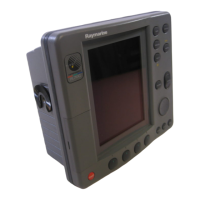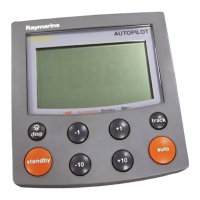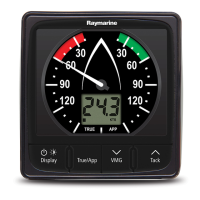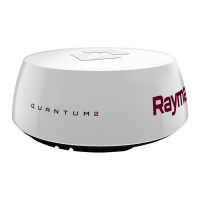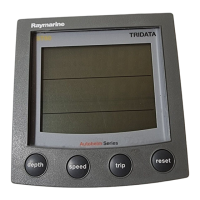Chapter 3: Standard Radar Operations 3-9
Adjusting Gain, Sea
Clutter, Rain Clutter
and Tune
Sea Clutter Control
Radarreturnsfromwavesaroundyourvesselcanclutterthecentreoftheradar
picture(see Figure 3-7,making it difficult to detect real targets. Such sea
clutterusually appears as multipleechoes on the displayat shortrange scales,
andtheechoesarenotrepetitiveorconsistentinposition.Withhighwindsand
extreme conditions, echoes from sea cluttermay cause densebackground
clutterin the shape of an almost solid disc.
Figure 3-7: Sea Clutter
TheSEA controlreducesthegainlevelin theareasnearyour vessel,extending
upto3to5nmdependingonthewaveandseaconditions.Thishastheeffectof
reducing the sea returns to intermittent small dots, while small targets are still
visible.Gain levelsfurther from your vessel remainunchanged.
YoucanusetheGainandSeacontroltohelpminimizetheeffectsofsidelobes
(seeIdentifying False Echo Returns on page 3-5).
Note: On short range scales, do not set the Sea control so high that all clutter
is removed, since this could stop you seeing echoes from close targets.
Tuning the Receiver
TheTUNE control is usedto fine tune thereceiverin the scannerformaximum
targetreturnsonthedisplay.InAutomode,theradartunesitselfautomatically
onallrangescales.WerecommendthatyouleavetheTUNE controlinAuto
mode.
If you do set the TUNE control to Manual,you will need to adjust it about 10
minutesafter you have turned on the radar, since the required setting changes
once the magnetron has warmed up.
You should adjust the control to obtain the maximum signalstrength, as
indicated in the 8-step bar above the slider. If you cannot tune the radar
successfully, refer to Section 7.6 for informationon the Tune Preset function.
SEA
MANUAL
75%
D3968-1
TUNE
A
U
T
O
81186_3.book Page 9 Thursday, August 22, 2002 8:23 AM

